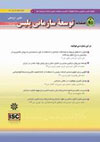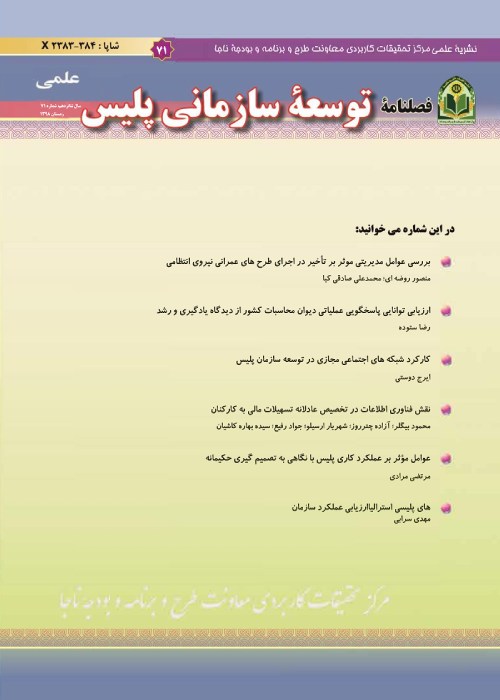فهرست مطالب

نشریه توسعه سازمانی پلیس
سال چهاردهم شماره 4 (پیاپی 63، زمستان 1396)
- تاریخ انتشار: 1396/12/01
- تعداد عناوین: 5
-
-
صفحات 11-28مدیریت راهبردی به معنای توانایی پیش بینی و تجسم آینده، حفظ انعطاف پذیری، تفکر راهبردی و پی ریزی تغییراتی است که باعث تحقق مزیت رقابتی برای سازمان در آینده خواهد شد. این مطالعه با هدف شناسایی و تبیین تاثیر مدیریت راهبردی بر عملکرد یک سازمان آموزشی- انتظامی طراحی و اجرا شد. برای این منظور چهار بعد از ابعاد مدیریت راهبردی مبتنی بر الگوی دیویس و چهار بعد از حوزه های عملکردی یک سازمان مبتنی بر الگوی چریدس با استفاده از مطالعات کتابخانه ای استخراج تا روابط میان متغیرهای آنها تحلیل آماری شود. برای گردآوری داده ها، پرسشنامه ای میان جامعه آماری متشکل از کارکنان و افسران آموزشگاه علمی- تخصصی شهید چمران ناجا توزیع شد و داده های حاصل از پاسخ های جامعه آماری با استفاده از تحلیل رگرسیونی چندگانه، مورد بررسی آماری قرار گرفت. نتایج نشان داد چهار حوزه عملکردی فناوری اطلاعات، منابع انسانی، بازاریابی داخلی و کیفیت تحت تاثیر مدیریت راهبردی است. به بیان دیگر، سازمان آموزشی باید برای پیاده سازی راهبردها و بهبود عملکرد، ابعاد مختلف مدیریت راهبردی را به شاخص های کلیدی عملکرد پیوند دهد.کلیدواژگان: آموزشگاه علمی- تخصصی شهید چمران ناجا، حوزه های کلیدی عملکرد، رگرسیون چندگانه، مدیریت راهبردی
-
صفحات 29-49هدف پژوهش حاضر، تاثیر ساختار سازمانی بر چابکی سازمانی در ناجا می باشد. این پژوهش از نظر هدف، از نوع کاربردی و از نظر نحوه گردآوری داده ها از نوع تحقیقات توصیفی- پیمایشی است. جامعه آماری آن را کارکنان ستادی فرماندهی انتظامی استان مازندران تشکیل می دهد. نمونه آماری شامل 219 نفر که به روش تصادفی ساده انتخاب شده اند. جمع آوری داده ها با استفاده از روش میدانی انجام گردید. به این منظور از پرسش نامه استاندارد ساختار سازمانی و از پرسش نامه استاندارد چابکی سازمانی استفاده گردید. پایایی سوالات با استفاده از فرمول آلفای کرانباخ به ترتیب 0/808 و 0/868 مورد سنجش و تایید قرار گرفت. داده های حاصل با استفاده از نرم افزار SPSS به دو روش توصیفی و استنباطی(آزمون کولموگروف- اسمیرنوف، ضریب همبستگی، رگرسیون و فریدمن) تحلیل شده اند. نتایج تحلیل آماری با استفاده ضریب همبستگی اسپیرمن بیانگر تاثیر ساختار سازمانی بر چابکی سازمانی می باشد. بر اساس نتایج آزمون فریدمن بیشترین میزان تاثیر بر ساختار سازمانی به ترتیب انعطاف پذیری، شایستگی، پاسخ گوئی و سرعت می باشد.کلیدواژگان: ساختار سازمانی، چابکی سازمانی، ناجا، مازندران
-
صفحات 50-73یکی از چالش های سازمان ها در شرایط پویا،پیچیده و رقابتی امروز پدیده تنبلی سازمانی می باشد.اهمال و سستی کارکنان در انجام وظایف خود به صورت جمعی معضلی است که سازمان های ایرانی بیش از گذشته با آن مواجه هستند.در پژوهش حاضر هدف،ارائه الگوی بومی تنبلی سازمانی و اولویت بندی موثرترین عوامل تنبلی سازمانی در سازمان های ایران می باشد.به این منظور با مطالعه ادبیات پژوهشی و پس از اعتبار سنجی به روش دلفی فازی از نظر 20 تن از خبرگان استفاده و 4 بعد و 15 مولفه شناسایی شدند. انتخاب خبرگان به صورت هدفمند و با روش گلوله برفی انجام شد. در مرحله بعد با استفاده از ترکیب فرایند تحلیل شبکه ای و دیمتل (DANP) و به کمک نرم افزار متلب تمامی روابط مستقیم و غیر مستقیم بین ابعاد و مولفه ها محاسبه گردید الگوی نهایی تنبلی سازمانی ارایه گردید سپس بر مبنای ضریب اهمیت رتبه بندی ابعاد تعیین شد:عوامل سازمانی،عوامل مدیریتی،عوامل فردی،عوامل محیطیکلیدواژگان: تنبلی سازمانی، الگوی بومی، دلفی فازی، دنپ، متلب
-
صفحات 74-98سازمان ها برای موفقیت، کسب رضایت ذی نفعان و حفظ بقای خود باید با محور قراردادن فرایندهای سازمانی، در راستای بهبود مستمر فرایندها تلاش کنند. مدل های بلوغ فرایندهای سازمانی، مدل هایی هستند که درراستای ارزیابی و بهبود فرایند سازمانی توسعه داده شده اند. مدل بلوغ قابلیت یکپارچه، مدلی است بنیادین که برای سنجش میزان بلوغ سازمان ها به کار می رود و با به کارگیری دانش و تجارب در مدیریت فرایندها و با تکیه بر این اصل که «کیفیت سیستم یا محصول متاثر از فرایندی است که در توسعه و نگهداری آن به کار رفته است»، ایجاد شده است. هدف این مقاله، ارائه مدلی برای ارزیابی سطح بلوغ فرایندهای کلانتری هاست که براساس آن بتوان درباره سطح بلوغ و اقدامات اصلاحی موردنیاز تصمیم گیری کرد. برای این منظور، پس از شناسایی فرایندهای سازمانی در کلانتری های منتخب ناجا و بررسی وضعیت موجود آنها و نیز با مدل برداری از مدل CMMI، مدل بلوغ قابلیت یکپارچه برای فرایندهای سازمانی کلانتری های ناجا توسعه داده شده است. مدل ارائه شده در این مقاله، مبنایی برای ارزیابی سطح بلوغ فرایندهای کلانتری های ناجا خواهد بود که براساس آن می توان نقاط ضعف و قوت فرایندها و اقدام ها و در نتیجه، کلانتری ها را نیز شناسایی کرده و براساس آن، راه کارهایی برای بهبود پیشنهاد داد.کلیدواژگان: فرایندهای سازمانی، حوزه های فرایندی، مدل بلوغ قابلیت یکپارچه، کلانتری ها
-
صفحات 99-122این تحقیق بر آن است تا به بررسی تاثیر امنیت شغلی بر اقتصاد مقاومتی در محیط یک سازمان نظامی بپردازد. این تحقیق از لحاظ روش توصیفی- پیمایشی و از لحاظ هدف کاربردی است. جامعه آماری این تحقیق شامل کلیه مدیران و کارشناسان ارشد و نمونه آماری شامل 95 نفر است که با استفاده از روش نمونه گیری تصادفی انتخاب شده اند. در این تحقیق پس از بررسی مدل های مختلف امنیت شغلی و استخراج مولفه های آن، مولفه ها مطابق با شرایط سازمانی جامعه مورد بررسی بومی سازی و در قالب ابعاد مختلف امنیت شغلی طبقه بندی گردید و با استفاده از پرسشنامه محقق ساخته اطلاعات جمع آوری و با به کارگیری آزمون تی برای یک نمونه، از فرآیند تحلیل شبکه(ANP)که در آن تعاملات سیستماتیک میان معیارها وجود دارد برای رتبه بندی عوامل و از روش آزمایشگاه ارزیابی و آزمون تصمیم گیری(DEMATEL) برای تعیین جهت روابط میان معیارها در جامعه هدف استفاده شده است. داده های تحقیق تایید و رتبه بندی شد. نتایج حاصل از تحقیق بیانگر آن است که همه مولفه های امنیت شغلی از جمله محیط و فضای کار، توانمندسازی کارکنان، رضایت شغلی، اطمینان خاطر کارکنان، عوامل مدیریتی و عوامل شغلی بر اقتصاد مقاومتی تاثیر گذار است و می توان نتیجه گرفت که امنیت شغلی کارکنان بر اقتصاد مقاومتی تاثیرگذار می باشد. همچنین نتایج حاصل از اجرای روش ترکیبی DEMATEL و ANP حاکی از آن است که رضایت شغلی کارکنان دارای بیشترین تاثیر و عوامل مدیریتی دارای کمترین تاثیر می باشد.کلیدواژگان: امنیت، امنیت شغلی، اقتصاد مقاومتی، روش DEMATEL، روش ANP
-
Pages 11-28Strategic Management (LS), causes competitive advantage for organizations in the future throughout forecasting and predictability, flexibility, strategic thinking, and continuous changing. On the other hand, the technology based world has created a new approach for the military organizations for strategic planning, work accelerations by means of outsourcing to create value for the stakeholders. To this end, an examination of strategic management effects on outsourcing in military organizations with the aim of performance improvement in the future would be valued. In this regard, data was collected through a questionnaire distributed among the target population including staff and officers in Shahid Chamran Scientific Military School. The result showed that the most parameters of strategic leadership are in positive and meaningful statistical relationship with outsourcing in military organizations. It is also predictable the finding of this research leads to a new vision of strategic and effective management and organization performance improvement in the future.Keywords: military organizations, Multiple regression, Outsourcing, Strategic management, Shahid Chamran Scientific Military School
-
Pages 29-49The purpose of this study was to investigate the effect of organizational structure on organizational agility in NAJA. This research is applied in terms of purpose and in terms of data collection method it is a descriptive-survey research type. The statistical population consists of staff of Police Command Officer of Mazandaran province. The statistical sample included 219 people selected by simple random sampling. Data collection was done using field method. A standard organizational structure questionnaire and organizational agility questionnaire were used for this purpose. The reliability of the questions using the Cronbach's alpha formula was 808.0 and 0.868, respectively. Data were analyzed by SPSS software using descriptive and inferential methods (Kolmogorov-Smirnov test, correlation coefficient, regression, and Friedman test). The results of statistical analysis using Spearman correlation coefficient show the effect of organizational structure on organizational agility. According to the results of Friedman test, the greatest impact on organizational structure is flexibility, competence, response and speed.Keywords: organizational structure, Organizational Agility, Naja, Mazandaran
-
Pages 50-73One of the challenges facing organizations in a dynamic, complex and competitive situation today is the phenomenon of organizational laziness. The weakness and weakness of employees in performing their duties collectively is a problem that the Iranian organization faces more than before. In the present research, the goal is to provide The native model of organizational laziness and prioritization are the most effective causes of organizational laziness in Iran's organizations. For this purpose, 20 research experts used the research literature and after validation by using Delphi fuzzy method, and 4 dimensions and 15 components were identified. Selection of experts was done purposefully and with snowball method. In the next step, using the combination of Dematel and network analysis process,(DANP), and using MATLAB software, all direct and indirect relationships between dimensions and components were calculated. The final model of organizational laziness was presented and then based on the importance of ranking the dimensions of determination : Organizational factors, Management factors, Individual factors, Environmental factors.Keywords: Organizational laziness, Indigenous pattern, Fuzzy Delphi, Danp, MATLAB
-
Pages 74-98The organizations need to continuously improve their processes so that they can succeed, increase their customers’ satisfaction, and survive. The process maturity models of organizations are models developed to assess and improve organizational process. In order that an organization can continuously improve, it is essential to focus on its maturity in personnel, process and organizational levels. The integrity maturity model is a fundamental model used to assess an organization’s maturity level. This model, based on the principle that “the system or a product’s quality is influenced by the process used in its development and maintenance”, is developed through reviewing all the knowledge and experiences gained from processes management. Organizations can advance with this model toward improvement of their processes and fulfillment of goals. In this paper, the concept of integrity maturity model is first reviewed; then, following indentifying organizational processes in the selected NAJA police stations and an examination of their statues que, the integrity maturity model for organizational process of the police stations was developed. The presented model in this paper can be regarded as a criterion to assess the maturity levels of process in the selected police stations, based on which the weakness and strengths of the organization can be identified.Keywords: organizational processes, integrity maturity model, Police Stations
-
Pages 99-122This research aims to consider the effects of job security on resistance economy in the environment of a military organization. This is a field-descriptive research from the point of method and practical from the point of goal. The population of this research encompasses all managers and prime specialists and the statistical sample includes 95 by random sampling. After consideration of different models in job security and excavation of its factors, they aboriginized based on organizational conditions and categorized into different dimensions of job security. Then the information gathered by researcher made questioner and analyzed by one-sample T-test for confirmation and Freedman test for ranking. The results showed that all factors of job security such as environment and atmosphere of work, employee empowerment, job satisfaction, employee's mind certainty, managerial factors and job factors effect on resistance economy. So, we can conclude that employee job security effects on resistance economy. The results from Freedman test also showed that employee job satisfaction is the most effective and managerial factors is the least effective factor.Keywords: Security, Job Security, resistance economy, Employee


